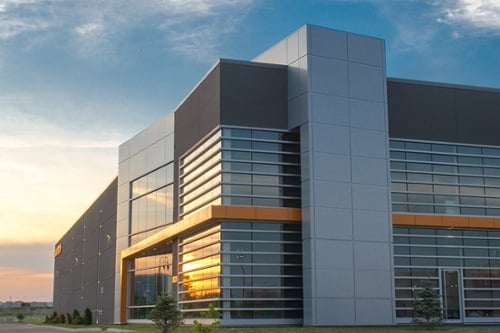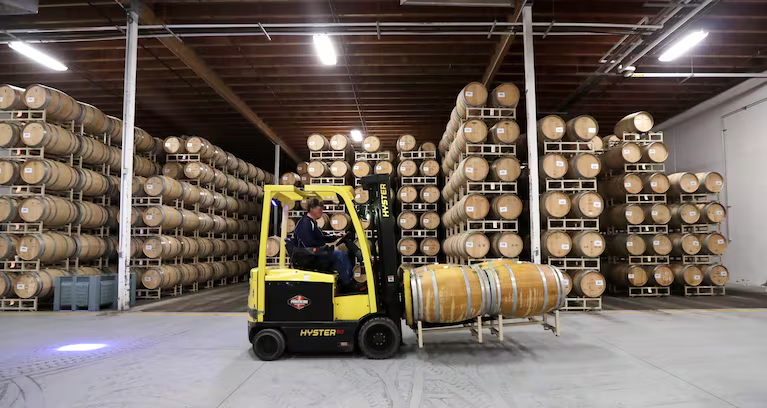With the U.S. importing nearly 37% of the wine it consumes, efficient and safe warehousing practices are vital for preserving product quality and meeting regulatory expectations. From temperature control to rack compliance, the wine supply chain demands precision.
Wine isn’t just a beverage—it’s an experience bottled in glass. But behind every perfectly poured glass lies a complex supply chain of precise handling, expert storage, and purpose-built warehousing.
Why It Matters
With the global wine market valued at $339.53 billion in 2020 and projected to reach $456.76 billion by 2028, the stakes for proper wine storage have never been higher. As consumption grows and vintages become more valuable, so does the need for reliable, efficient, and safety-compliant wine warehousing.
Whether you manage a small wine boutique or a high-throughput distribution center, how you store your wine matters—a lot. Temperature fluctuations, racking damage, improper rotation, and even minor forklift collisions can compromise quality or trigger regulatory red flags.
In this guide, we’ll uncork the 7 essential elements of modern wine warehousing, so you can protect your inventory, meet evolving standards, and preserve every nuanced note of flavor. To help you put these strategies into action, we’ve included a quick FAQ addressing common warehouse safety questions—plus a practical checklist to guide your next audit.
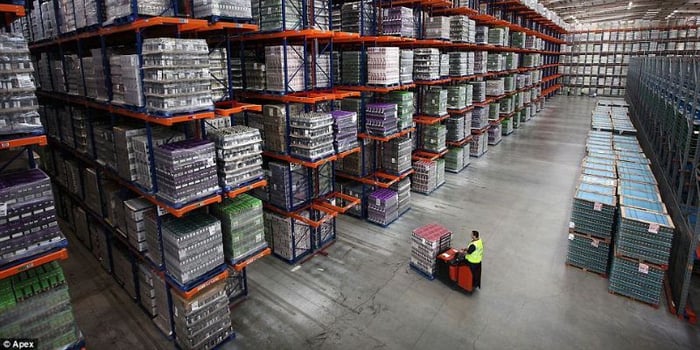
Photo credit: Daily Mail UK
Table of Contents
1. Temperature & Humidity Control
Temperature and humidity control are foundational to wine warehousing success. Even minor fluctuations can compromise flavor, structure, and shelf life. The optimal storage temperature for wine ranges between 55°F and 59°F (13°C–15°C), while humidity should be kept between 50% and 70% to prevent corks from drying out and oxidizing the wine.
A robust HVAC system with real-time climate monitoring is critical in large-scale storage facilities. Automated sensors and software should continuously track temperature and humidity to ensure consistency throughout the space. Air circulation also plays a vital role by minimizing mold growth and maintaining uniform conditions across all rack levels.
Why it matters: Temperature instability can lead to premature aging, while high humidity risks label damage and mold, and low humidity causes cork degradation. Each threatens the product quality and compliance.
💡 Pro Tip: Implement a centralized climate control system with automated alerts and backup power (e.g., generators). This ensures uninterrupted protection—even during outages or peak seasonal fluctuations.
2. Light & Vibration Protection for Wine Warehouses
Light exposure and vibration are two silent threats that can compromise wine quality during storage. Without the right controls, these factors can cause irreversible damage to aroma, flavor, and aging potential.
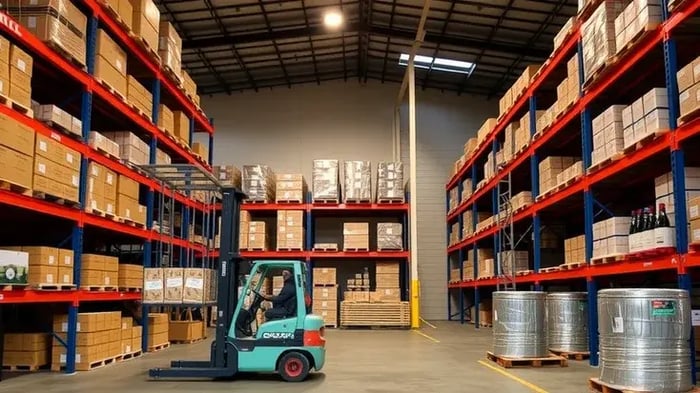
Photo credit: www.wine-searcher.com
Why Light Control Matters
Wine is highly sensitive to blue and ultraviolet (UV) light, which can trigger a chemical reaction known as light strike (or goût de lumière). This reaction breaks down amino acids and sulfur compounds, leading to unpleasant sensory effects.
Symptoms of light strike include:
- Skunky or wet cardboard aroma
- Cabbage, garlic, or burnt rubber notes
- Loss of fruitiness and freshness
To minimize light exposure in wine warehouses:
- Use low-intensity lighting like amber LEDs or incandescent bulbs
- Install motion sensors or timers on lighting systems
- Apply UV-filtering film on windows and doors
- Prefer amber or dark green bottles over clear or light green ones
The Impact of Vibration
Vibration can disturb the sediment in wine and accelerate chemical aging. Facilities near heavy machinery or docks are especially at risk.
- Secure racking systems to the floor
- Design forklift and conveyor paths to minimize jolts
- Use shock-dampening pads beneath sensitive zones
- Isolate premium vintages from high-traffic areas
💡 Pro Tip: Evaluate your warehouse layout for vibration hotspots—especially near pallet flow systems—and install anti-vibration supports where needed.
3. Industrial Wine Racks: Storage Types & Safety Considerations
Wine storage racks are more than shelving—they are structural safety systems. In any warehouse, especially those handling alcohol, racking must be engineered to support high loads, prevent collapse, and allow for efficient inventory rotation. Below are the most common rack types used in commercial wine warehousing.
Wine Case Storage on Standard Pallet Racking
For long-term or slow-moving SKUs, storing wine cases in their original cartons on static pallet racks offers bulk efficiency. This setup is not designed for frequent access to individual bottles, but is ideal for:
- Maximizing cubic storage in temperature-controlled environments
- Reducing energy use by consolidating climate zones
- Supporting predictable inventory with minimal handling
Pallet Flow Racking for High-Volume Wine Rotation
Pallet flow systems use gravity to advance wine pallets from rear-load to front-pick positions. This layout supports First-In, First-Out (FIFO) inventory, which is essential for preserving wine freshness and quality.
Benefits include:
- Reduced forklift travel and touchpoints
- Faster picking and restocking
- Lower risk of bottle damage due to smoother handling
Even minor rack damage in flow systems can compromise structural integrity. Be sure to install column guards and conduct regular rack inspections to avoid costly failures.
Bottle-Pick Racks for Broken or Partial Cases
Some racks feature bottle-pick lanes designed to glide individual bottles forward as each one is removed. These are front-loaded systems ideal for:
- Managing open or broken cases
- Keeping high-turn SKUs within easy reach
- Integrating directly into pallet rack bays with simple retrofits
High-Density Mobile Shelving for Compact Warehousing
Mobile shelving systems eliminate fixed aisles by placing wine racks on movable carriages. Aisles open only when needed, maximizing storage density in tight warehouse footprints.
Advantages:
- Store up to 4× more inventory in the same space
- Easy to operate—even with heavy loads
- Ideal for slow-moving vintages or archival collections
Case in point: Williams Selyem Winery in Healdsburg, CA, quadrupled its storage capacity to 2,000 cases using mobile wine shelving.
Secure Wine Storage Lockers
For rare, high-value, or allocated inventory, lockable storage cages provide both security and airflow. Made with wire mesh partitions, these lockers:
- Limit access to authorized personnel
- Promote even climate control
- Offer flexible use for collectors, distributors, or bonded storage
Barrel Racks for Fermentation and Aging
Barrel racks are designed for vertical stacking—often 2 to 5 barrels high—while enabling forklift access and safe repositioning. The contoured shape of these racks keeps barrels stable and:
- Preserves cleanliness by elevating barrels off the floor
- Improves selectivity for small-batch aging
- Maximizes use of vertical space in climate-controlled zones
Drive-In and Drive-Through Racking
When space is limited and product turnover is uniform, drive-in and drive-through racks reduce the number of aisles required.
- Drive-in: LIFO storage, ideal for aging wine, not frequently rotated
- Drive-through: FIFO method, allowing access from both ends
These systems work best with standardized pallets and forklifts trained for deep-lane access. Safety inspections and seismic design considerations are critical here.
Rack Selection Tips for Wine Warehousing
When selecting a racking system, always evaluate:
- Load capacity for both weight and frequency of handling
- Seismic code compliance in your region (e.g., California’s CBC)
- Ventilation spacing between racks to maintain temperature uniformity
💡 Pro Tip: Use Damotech’s structural inspection and repair services to ensure your racking meets ANSI standards and remains OSHA-ready.

4. Wine Inventory Management & FIFO Rotation Strategy
Effective inventory management is essential to maintaining wine quality and avoiding costly spoilage. Unlike other products, wine is vintage-sensitive—older stock typically needs to move first. That’s why First-In, First-Out (FIFO) is the preferred inventory rotation method in most U.S. wine warehouses.
FIFO vs. LIFO in Wine Warehousing
- FIFO (First In, First Out): Prioritizes shipping older vintages first. Ideal for freshness, quality control, and minimizing loss.
- LIFO (Last In, First Out): Moves newer stock first. Common in accounting but impractical for vintage-specific wine inventory.
Because wine often has a limited optimal aging window, proper rotation ensures your product is consumed at peak condition while keeping inventory accurate for audits and reporting.
Enhancing Operations with Warehouse Management Systems (WMS)
Implementing a Warehouse Management System (WMS) helps automate and streamline wine storage operations, especially in high-volume facilities with diverse SKUs.
Top benefits of a WMS include:
- Real-time tracking by vintage, varietal, lot, or case
- Optimized slotting and pallet location assignments
- Efficient pick-paths for fulfillment and restocking
- Integrated alerts for expiration thresholds or stagnant SKUs
Platforms like Ekos offer wine-specific tools that support intelligent stock rotation and order accuracy.
Lot-Level Tracking for Traceability & Compliance
Modern WMS platforms allow warehouses to use SKU-level and lot-based tracking for granular control. By tagging each case or bottle with barcodes or RFID chips, staff can:
- Instantly locate and pick the correct vintage
- Reduce mispicks and cross-contamination of SKUs
- Provide full traceability for audits and recalls
- Monitor movement patterns for high-value or allocated products
This level of oversight builds confidence with distributors, simplifies reporting, and ensures compliance with U.S. inventory and alcohol control regulations.
💡 Pro Tip: Integrating barcode or RFID scanning with your WMS accelerates pick rates, improves accuracy, and keeps FIFO rotation airtight.
5. Wine Logistics and Distribution
Wine logistics involves far more than just moving products from point A to point B. It includes managing temperature-controlled transport, ensuring regulatory compliance, optimizing warehouse throughput, and supporting last-mile delivery for retail, restaurant, and distributor networks.
The United States is the fourth-largest wine producer in the world, but it still imports nearly five times more than it exports. This makes international and domestic logistics mission-critical to wine supply chain operations.
To meet these demands, many producers and importers partner with third-party logistics providers (3PLs) that specialize in alcohol distribution. These partners offer temperature-regulated warehousing, customs expertise, bonded storage, and real-time shipment visibility.
Cold Chain Logistics and Transit Protection
Maintaining climate integrity throughout the supply chain—known as the cold chain—is essential. Exposure to high temperatures during transit can lead to spoilage, cork push, or chemical degradation. Warehouses and 3PLs should ensure that:
- Trailers and containers are temperature-controlled
- Inventory staging areas remain insulated
- Real-time temperature logging is available at every touchpoint
- Routing avoids high-heat zones during summer months
Automation in Wine Warehousing and Fulfillment
Warehouse automation is transforming wine logistics. Tools like automated storage and retrieval systems (AS/RS), pallet shuttles, and conveyor belts allow warehouses to scale operations without sacrificing accuracy.
Key benefits of automation in wine distribution:
- Faster order fulfillment with fewer picking errors
- Optimized SKU slotting based on velocity and vintage
- Real-time tracking integrated with WMS platforms
- Predictive replenishment and expiration alerts
On the distribution side, wine suppliers increasingly use digital ordering platforms, which allow retailers and restaurants to place orders online, check availability, and track delivery status. This eliminates email and phone delays while improving order accuracy and customer satisfaction.
💡 Pro Tip: Partner with a 3PL that specializes in wine logistics and offers bonded, climate-controlled transport, digital ordering tools, and real-time inventory visibility to reduce spoilage risk and increase distribution efficiency.
6. Security and Theft Prevention in Wine Warehouses
Wine—especially rare vintages and premium labels—is a high-value product that requires rigorous security protocols. Warehouse theft can lead to substantial financial losses and reputational damage, making proactive security a critical aspect of wine storage management.

Wine theft—like this clumsy attempt—is why secure lockers, access controls, and smart surveillance are important in warehouse storage.
Facilities should begin with access control measures such as keypad entry, keycard systems, or biometric scanners to limit who can enter secure areas. Strategically placed security cameras with real-time monitoring provide visibility across critical zones, including loading docks, high-value lockers, and restricted vaults.
For added protection, some warehouses designate climate-controlled vaults or cages for rare collections, using wire mesh partitions to maintain airflow while restricting access. Layering these systems with smart surveillance, intrusion detection, and motion-activated alerts further strengthens the security perimeter.
Routine inventory audits and reconciliation reports also help identify discrepancies early, whether caused by theft, damage, or administrative error. When integrated with your warehouse management system, these audits can be automated and tied to employee access logs.
💡 Pro Tip: Install AI-enabled security cameras near pallet zones, barrel racks, and bonded wine lockers to flag unauthorized movement, track employee access, and generate automatic alerts when conditions deviate from normal operations.
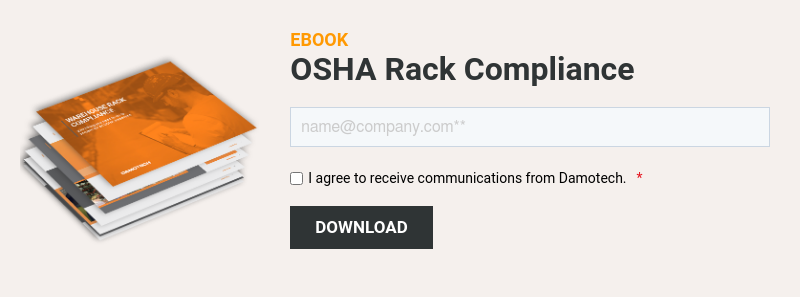
7. Safety and Compliance in Wine Warehousing
Wine storage facilities face unique safety challenges—combining the risks of fragile glass, dense pallet loads, forklifts, and temperature-sensitive inventory. Proactively managing compliance isn’t optional—it’s the foundation of risk mitigation and operational reliability.
Meeting Safety Standards and Worker Protection
Warehouses must comply with:
- Local building and fire codes
- OSHA standards for warehouse operations
- Environmental and chemical handling regulations
Regional regulations also come into play. For example, California’s Building Code (CBC enforces strict seismic anchoring for racking systems, while Washington State’s L&I safety standards emphasize emergency egress and PPE protocols. If your warehouse operates in New York, Oregon, or other alcohol-regulated states, additional requirements may apply for bonded storage, environmental control, and fire protection. Operating in California, Oregon, or Washington? Speak with a Damotech rack safety expert familiar with your regional code requirements.
To minimize accidents and citations, employees should be regularly trained on:
- Safe lifting techniques and proper use of equipment
- Handling of cleaning agents or sanitizing chemicals
- Personal Protective Equipment (PPE) use
- Emergency evacuation and incident reporting protocols
Clean, obstruction-free aisles, exits, and work zones are essential to both compliance and day-to-day safety.
Rack Safety and Structural Integrity
In wine facilities, high-density racking is often used to store fragile and valuable inventory. Damage to racking from forklift impacts, overloading, or improper reconfiguration can result in injury, product loss, and legal exposure.
To ensure rack safety:
- Schedule third-party inspections by certified rack engineers
- Repair damaged uprights and braces using engineered repair kits
- Install impact protection like column guards and end-of-aisle barriers
- Display current load capacity signage and maintain LARC documentation
Warning: Forklift collisions are one of the leading causes of rack collapse. Protect your most vulnerable rack positions with fixed impact-resistant barriers.
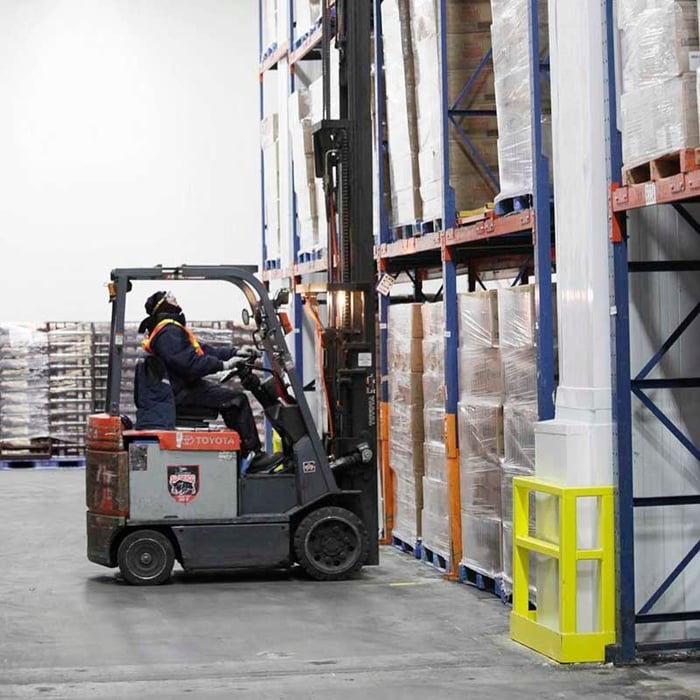
Damo Fence and Damo Guard in action—shielding racking columns and warehouse column from forklift damage and keeping your wine warehouse OSHA-compliant.
Labeling, Documentation, and Regulatory Records
Accurate product labeling and proper rack documentation are crucial for:
- Tracking vintage and origin for international compliance
- Meeting excise tax and bonded storage requirements
- Supporting traceability in case of product recalls
Label racks with load limits and maintain updated inspection records to meet OSHA standards.
Emergency Preparedness Planning
Natural disasters, power outages, and even minor incidents can escalate quickly in warehouse environments.
Wine warehouses should:
- Develop and regularly update emergency response plans
- Conduct employee drills for fire, earthquake, and rack failure scenarios
- Prepare contingency procedures for HVAC outages in climate zones
- Store emergency kits and ensure exits and alarms meet code
💡 Pro Tip: Include rack collapse in your emergency planning. Damotech offers detailed rack inspection reports and engineered repair strategies to help facilities prepare for—and prevent—structural hazards.

Conclusion: Setting the Standard for Safe and Efficient Wine Warehousing
Mastering wine warehousing is both a science and an art. From climate control to inventory rotation and advanced automation, every element of wine storage contributes to product quality and smooth operations.
As the global wine market grows, so does the need for specialized storage systems that prioritize safety, performance, and compliance. This is especially true in regions like California—the U.S.’s largest wine-producing state—where seismic activity and environmental regulations raise the bar for compliance. Likewise, facilities operating in New York, Washington, or Oregon must adhere to state-specific OSHA standards and wine-handling protocols. Structurally sound racking, regulatory readiness, and proactive risk planning are essential for protecting not just your inventory, but also your employees and business continuity.
This is where Damotech makes a difference. As North America’s leader in rack inspection, repair, protection, and safety training, we understand the unique challenges of wine warehousing. Our engineers and safety experts help you build a stronger, safer operation—one rack at a time.
Contact us today to learn how Damotech can support your wine warehousing strategy—from expert inspections to safety programs that protect your product and your peace of mind.
✔ Final Takeaway
Don’t wait for a rack failure or inspection citation. From temperature to training, Damotech helps warehouses stay compliant and safe, rack by rack.
Schedule your rack safety consultation today.
FAQ - Wine Warehousing Questions
What’s the best temperature for wine storage?

Between 55°F and 59°F with consistent humidity control to prevent oxidation.
How do I prevent a wine rack collapse?

Use ANSI-compliant racking, routine inspections, and Damotech structural repairs after damage.
Which rack type is best for aging wine?

Drive-in pallet racks or barrel racks are commonly used for long-term, undisturbed storage.
How often should wine racking systems be inspected?

At least every 6–12 months or immediately after a forklift collision or seismic event. Damotech recommends a certified rack safety inspection annually.
Does OSHA regulate wine warehouses?

Yes. The National Emphasis Program targets warehousing, with rack failures and forklift incidents frequently cited.
Are wine warehousing regulations different in California or Washington?

Yes. States like California require seismic safety features under CBC codes, and Washington and Oregon apply specific labor and bonded storage rules. Always consult regional OSHA or liquor control boards for up-to-date compliance guidance. Planning for seismic compliance? Don’t miss our Seismic Zone Rack Safety Guide.
Do I need different racking for barrels vs. bottles?

Yes. Barrel racks must support stacking and forklift handling, while bottle-pick racks are ideal for individual bottle access and broken cases.

